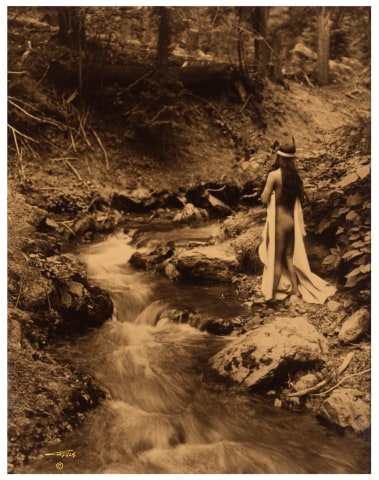The Maid of Dreams, 1909
Orotone
35 x 27 cm
Copyright The Artist
'The Maid of Dreams' is one of those rare photographs that tells its own story. It draws the eye of the viewer not only to the compositional structure of the...
"The Maid of Dreams" is one of those rare photographs that tells its own story. It draws the eye of the viewer not only to the compositional structure of the image but also to the lost and often sad story of the North American Indians.
More specifically, this photograph employs a correspondence between the river and the other elements of the picture. Just as the river flows, the hair flows, the cloth flows, the unclothed part of the body flows as well. It is as if the nature of the body itself flows into the natural world surrounding it. In this respect the body becomes as naked and as natural as the surrounding environment, all then seems naked. The source power of the image comes from its ability to disrobe the truth and its harmony with the nature it portrays.
Curtis always wished his photographs to be printed in such a way that one could even see the pores of the skin. He was lucky to have "The Maid of Dreams" printed in photogravure, extraordinarily on glass instead of copper. Thanks to this technical aspect, the purity of the water, the roughness of the stones and the rest of nature all together reflect a desire in a sublime way which is a longing for what is no more and for what was nearly lost: an unspoiled natural world as well as the freedom and dignity of the American Indians.
© Cigdem Mirol
More specifically, this photograph employs a correspondence between the river and the other elements of the picture. Just as the river flows, the hair flows, the cloth flows, the unclothed part of the body flows as well. It is as if the nature of the body itself flows into the natural world surrounding it. In this respect the body becomes as naked and as natural as the surrounding environment, all then seems naked. The source power of the image comes from its ability to disrobe the truth and its harmony with the nature it portrays.
Curtis always wished his photographs to be printed in such a way that one could even see the pores of the skin. He was lucky to have "The Maid of Dreams" printed in photogravure, extraordinarily on glass instead of copper. Thanks to this technical aspect, the purity of the water, the roughness of the stones and the rest of nature all together reflect a desire in a sublime way which is a longing for what is no more and for what was nearly lost: an unspoiled natural world as well as the freedom and dignity of the American Indians.
© Cigdem Mirol
